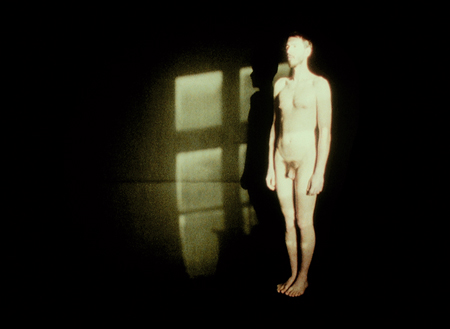In "Vom Innen; von aussen" Albert Sackl, while standing naked in a black box, animates his own body with a series of single frames exposed in the film camera. While doing so director Sackl choreographs the movements of model Sackl to the minutest detail, turning the body, which stands at ease, not playing an active role, on its own axis and back again. Later, illuminated by stroboscopic flickering, he and his double rotate side by side in opposite directions, the flickering caused by the alternation between the individual frames, first on the left, then the right.
As if even this rigid arrangement was eventually too much for the apparatus, the camera occasionally pans outside the neutral box, across the studio and to a mirror on the wall where the lead actor can be seen dashing to and fro. Experimental films which are so precise technically and at the same time demonstrate a sense of humor are rare.
Frontal views of the body alternate on the fly with rear views until they blur in a trompe-l‘oeil effect: A being which defies the laws of perspective is created before our very eyes, and it seems strange and familiar at the same time.
When Vom Innen; von aussen finally leaves the studio to continue the test series outdoors, surrounded by bushes, on snow and ice in bare feet, it becomes clear that Sackl‘s desire to experiment is based on more than a purely aesthetic decision. While in the background the wind sets the entire forest scenery in motion, while the sun flickers and the darkness begins to descend, the camera continues to animate Sackl‘s body stoically, letting it wander closer and then farther away, as if it existed in another, parallel cosmos which, disconnected from the time of day and season, is subjected to its own mechanical laws.
Observing something from the outside and at the same time talking about the inside: one possible definition of successful cinema.
(Maya McKechneay)
Translation: Steve Wilder

